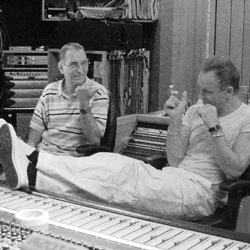Harlem-born Grammy-winner Dave Darlington is somewhat of an all-rounder when it comes to music. He still prides myself on being a musician first, but it was his love of music that got him into engineering, mixing, and then mastering.
“I never wanted to be pigeon holed,” he tells us; and with the kind of eclectic projects he’s got going on right now, we don’t think there’s much danger of that.
We find out more about the man behind the music.
When Darlington ‘got started’ in the studio game, it was the 1980s, and Latin freestyle music was rife. He was working with the Latin Rascals and Louis Vega, that whole Latin scene, but didn’t want to be known as ‘that Latin freestyle engineer’ so he began making different musical waves.
“I didn’t really see myself as a mastering engineer, but the album that really turned the corner on that for me was Ambrose Akinmusire, the jazz trumpet player,” Darlington recalls. “We mixed the record together, and I recommended a mastering guy. I really liked the way it turned out, and the mastering guy came back to me and said he also really liked the way I had it sounding, so suggested I assemble the CD myself. I said, ‘I guess I could’, and that ended up being a pretty big record, and changed my mind about whether or not I could master.”
In today’s digital realm, many people don’t have the extra budget to go to a separate mastering engineer, so after mixing a record, Darlington will often offer to do the mastering himself.
“I mean, I’ll always say to my clients that it’s great if you can afford to have a second set of ears, because it is, but at the end of the day, we are putting out records that people like, so mastering it here is a viable option,” he says.
When it comes to mixing, Darlington works very much in the box, though also has a sizeable box of analog toys, which are key in his process.
“I have a bunch of Neve 1073s, and a bunch of APIs, then an LA2A and 1136, but that’s for recording,” he explains. “Now, if I’m going to cut a drum kit, or a vocal, or a horn section, once I get it in the box, I will try not to over compress or EQ going in. If I wan to put in an EQ, I’ll put the Waves Scheps EQ in there—that’s as good a Neve as you’re going to get—and, if you record with the EQ, you’re stuck with it: this way, you can change it if you need to. I also mix with the mastering chain on fairly early, when I am really trying to scope the level of stuff, so I can hear how it’s going to react.”
When it comes to mixing, Darlington’s effects suite is largely Waves based, of which he has a few particular favourites.
“I rely pretty much on Waves reverbs and delays when mixing; I am a big fan of True Verb and R Verb, and they just came out with a new one called H Verb, which is really, really powerful, so between those three, that’s my ambient settings,” Darlington reveals. “Then, within the tracks themselves, I love to use the Renaissance EQ, the Renaissance compressor, and the RVox compressor. I pretty much keep them in my bag of tricks, as it’s so easy to use, and they sound so good.
“There are a million EQs out there that you can choose from, and they all have their pluses and minuses, but Waves seem to have figured out a way to just simplify everything for the users, without sacrificing any sound quality. I think it’s probably down partly to their longevity; as a company, Waves has been in the game since the beginning of digital, and they really have a feel for how things should sound. It’s unbelievable, actually. I don’t know what goes on under the hood in terms of programming, but it’s kind of like driving a sports car, you’re not really of how the fuel injections are working, but when you mash the pedal, it goes! That’s what I love about Waves.”
















